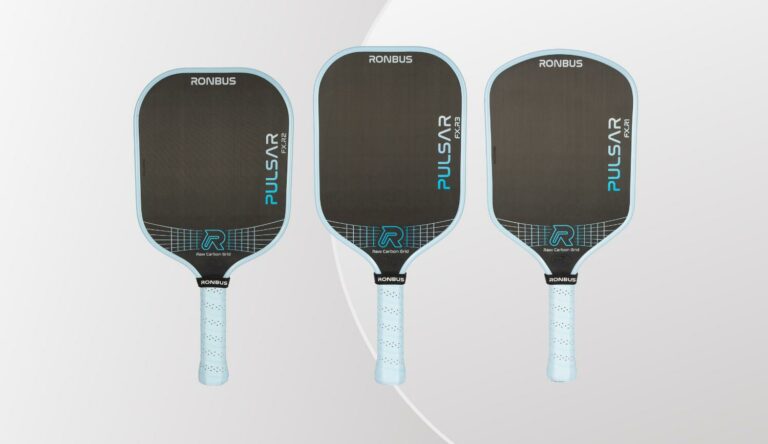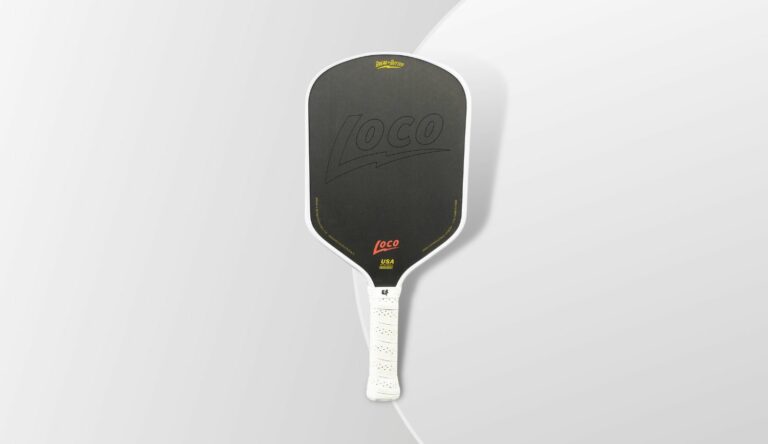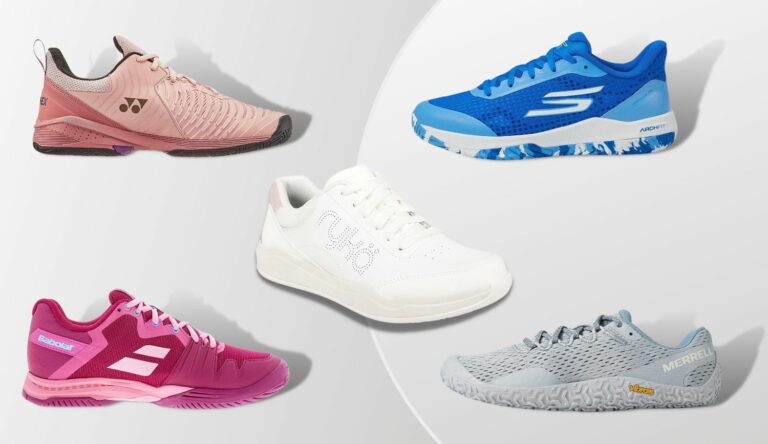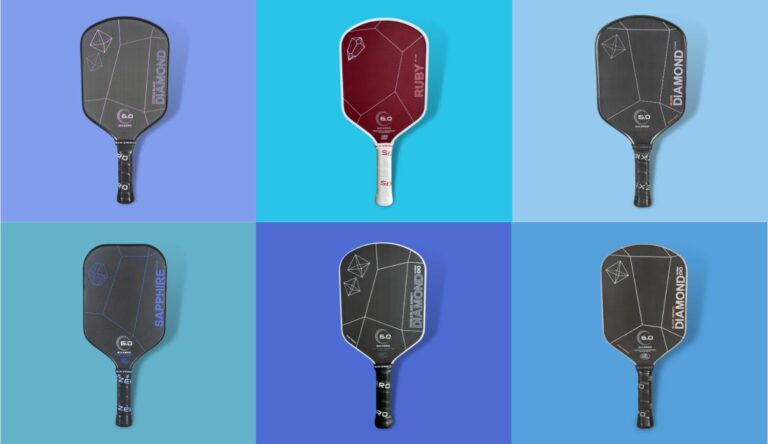Doubles pickleball gets more attention and fanfare, but singles is still a ton of fun. Singles is an excellent variation of the game that’s full of its own unique strategies and thrills. It also keeps you in shape and makes you a stronger doubles player.
Although they share many similarities, the strategy for singles play is overall quite different than for doubles.
Here are some key differences between singles and doubles pickleball:
- Singles is more physically demanding than doubles because you have to cover the entire court and make every shot yourself
- Singles is a far more offensive-focused game compared to doubles. Power and speed dictate singles far more than the soft game
- Singles requires you to think a bit broader and more strategically about body placement and court coverage
In this post, we’re going to deep-dive into essential areas of the game that you’ll need to understand and perfect if you want to excel as a singles player.
These strategy tips will be helpful if you’re a new singles player or an old pro that needs a refresher.
Let’s dive in.
Contents
- 1. Optimize your serves
- 2. Optimize your returns
- 3. Emphasize getting to the Kitchen/NVZ line
- 4. Keep your opponent pushed back from the Kitchen/NVZ line
- 5. Stay in front of the ball and your opponent while prioritizing covering the middle of the court
- 6. Study your opponent’s tactics, weaknesses, and tells
- 7. Move your opponent around the court
- 8. Take advantage of your opponent’s momentum
- 9. Be unpredictable with your shot selection and tactics
- 10. Always be on the lookout for passing shot opportunities
- 11. Work to minimize unforced errors
- 12. Keep up on physical fitness
- 13. Get the right paddle and footwear
- In conclusion
1. Optimize your serves
The serve and return are very important to dial in for singles pickleball. Since you have to cover the whole court, a poor serve leaves you uncomfortably exposed. You need to put pressure on your opponent or you’ll end up getting burned by a strong return.
Do the following to make your serves a true offensive weapon:
- Hit deep. Deep serves push your opponent back to the baseline and make it hard for them to hit a clean return. This sets you up for a much better third shot, which is often the most pivotal shot in a rally.
- Hit hard. Hitting hard gives them less time to react and set up a clean return.
- Hit to their backhand. Hitting to the backhand or weak side is always a good idea. But if you struggle to hit specific corners with consistency, focus on depth and pace first. Hitting hard and deep is more important than specific placement.
- Serve from near the center line. This lessens the time and steps needed for you to get the best angle on your opponent’s return, whether it’s to your forehand or backhand. With that said, you should also mix up your service locations to an extent (more on being unpredictable later).
And remember, you want to immediately get into a ready position after hitting your serve to set you up for a great third shot.
2. Optimize your returns
Just like the serve, a good return is essential for success in singles pickleball.
If you hit a short, lazy, or otherwise ineffective return to your opponent, they’ll be able to easily hit whatever type of third shot they want.
You don’t want this at all as the receiver because the 3rd shot gives you a natural positional advantage over the serving side. You want to make the 3rd shot as hard for them as possible.
A good singles return is:
- Hit deep. You want to keep your opponent back away near the baseline as much as possible. A deep serve return won’t allow them to get up to the net as easily. If you can make your deep return float a bit with a slice, even better. That gives you more time to get to the kitchen and prepare for their third shot.
- Makes your opponent move. You want to try to keep your opponent off balance as much as possible. You can do this by hitting to the opposite side of the court they’re on. When they’re forced to move around, they won’t be as stable and are more likely to make errors. They also will be creating momentum that you can take advantage of (more on that later).
- Exploits any weaknesses. Typically you’ll want to return to your opponent’s backhand side, as most players have weaker backhands than forehands. But you can also hit certain areas of the court that you know they have trouble getting to or hitting from.
Above all, prioritize making your serve returns land in bounds. Don’t push small margins of error too far. If you’re aiming deep, don’t try to hit the baseline tape. Instead, aim for the back foot or two of the court.
If you hit a poor in-bounds return, be prepared to stay back at the baseline instead of rushing toward the net. You don’t want to get hit by an aggressive passing shot while racing to the kitchen.
3. Emphasize getting to the Kitchen/NVZ line
Points are usually won from the kitchen line, especially in men’s singles. Angles are everything in singles, and you limit your opponent’s ability to take angles on you by reducing gaps when playing from the kitchen. High-level players will rarely stay back near the baseline unless it’s absolutely necessary.
You don’t have to make your way to the net every point, but typically, you’ll apply more pressure on your opponent from the NVZ when you do. Having a strong ability to play the net game forces your opponent to think harder about how they want to approach their shots.
To do this right, you’ll need to learn the best strategies to get up to the net. You’ll have to hit the right shots and move at the right time. It’s no fun getting caught in no-man’s land with a shot to your feet, or worse, getting a passing shot blazing past you. If you’re taller, you have more leeway here. Shorter players with smaller wingspans have to be picky about when to move up and be extra conscious about potential gaps to cover.
4. Keep your opponent pushed back from the Kitchen/NVZ line
If you can get to the kitchen and keep your opponent deep, you’re in a great place offensively. You want to keep them deep while you take advantageous positioning at the kitchen line.
You can use power and placement to your advantage here. Always answer one of their deep shots with a deep shot of your own. You almost never want to hit a short shot when your opponent is deep, as giving them a free opportunity to move forward is going to hurt you.
If they get to the Kitchen before you do, you can try to hit a passing shot on them, a drop shot that allows you to move up, or a lob. These are hard shots to make, though, especially the lob. So work on getting to the kitchen before them.
5. Stay in front of the ball and your opponent while prioritizing covering the middle of the court
Singles is particularly challenging because you have to cover the whole court. You’ll need to minimize opportunities that your opponent has to get the ball past you.
To accomplish this, you’ll typically want to move where your opponent moves horizontally while still keeping a bit of emphasis on remaining close to the center line.
Keep the centerline as your main point of reference while mirroring their overall movements. Work to close gaps without getting pulled too far in one direction. If you get pushed too far out of position, attempt to reset the ball to the middle of the court so you can move back closer to the center.
The most important takeaway is that you never want to get caught leaning too far to one side of the court.
6. Study your opponent’s tactics, weaknesses, and tells
If you want to be a successful singles player, you have to focus on how to exploit their game. High-level players are always zeroing in on their opponent’s strengths, weaknesses, and style of play.
Focus on:
- Their weakest side. Most often, this will be the backhand. But some players have more developed backhands. Get a sense of what their weakest side is, and leverage it by hitting it constantly.
- Their form and movement when setting up specific shots. Many players telegraph what type of shot they’re about to hit. You want to analyze what pre-shot rituals they might have so you can prepare to defend against what will likely be the next shot.
- Their level of athleticism. How quickly are they able to close gaps and switch up their momentum? If they struggle to cover drop shots from large distances, you might consider dropping shallow on occasion instead of always driving them deep when they’re back at the baseline.
7. Move your opponent around the court
For success in singles, you want to keep your opponent moving constantly. This keeps them playing defensively and makes it more challenging for them to hit effective and accurate shots.
Always keep an eye out for where your opponent is on the court and where the open space is. Hit to the areas of the court that you know will make them move, and then hit the opposite zone after they’ve returned that shot. Run them to the left, then to the right.
Your game will improve drastically as you get better at placement with crosscourt shots and are increasingly aware of where to hit to get them to move.
8. Take advantage of your opponent’s momentum
The next level of hitting to where your opponent will have a hard time getting to prioritizes awareness of momentum. Momentum can often be more important than open court space when playing against speedy and agile players.
Sometimes it might feel like you should be hitting cross-court to get the winning shot, but if your opponent has already shifted their momentum and is moving pre-emptively to that open space, your better shot would be to hit it behind them, right where they just were.
So keep closely tuned into how they move their body and shift their momentum. If you can sense them leaning to the left or right in anticipation of your shot, send the ball the opposite way before they have a chance to switch up.
Once you can exploit both open court space and momentum, your opponent will struggle immensely to know which direction to look towards. This will confuse them, slow them down, and give you a huge upper hand.
9. Be unpredictable with your shot selection and tactics
High-level singles players know how to mask and mix up their game to devastating effect. You always want to vary your shots so your opponents can’t anticipate your game. You always want them on their toes, unsure of what shot you’re going to make.
Right when they think you’re in a rhythm with a specific shot, switch to another. When you’ve been employing a specific strategy and they’ve started to pick up on it, switch things up suddenly.
Throw in lobs or unexpected drives after you’ve been dinking a lot. Telegraph a hard drive, but at the last second dink it to a corner on their backhand side. Drive deep on your serves and returns, but suddenly hit a short shot when they clearly aren’t expecting it. C
The more you play, the more this strategy will develop. Your techniques, shot selection, and tactics will expand naturally, and you’ll be able to become a swiss army knife out there.
10. Always be on the lookout for passing shot opportunities
You always want to see opportunities to drive a winning ball right past your opponent whenever they set up with weak positioning. The best times to do this will be when your opponent is moving to the net or chasing down a ball to either side of the court.
You can also hit great passing shots right down the line when you’re moved out to the sides and they aren’t covering that angle well enough. Just be cautious not to try to hit directly on the line, aim for 6-12″ from the line to better avoid hitting an out ball.
11. Work to minimize unforced errors
You want to avoid going for too much and trying to hit winning shots all the time. Focus on keeping consistent and limiting high margin of error shots that can lead to you making more mistakes.
Instead, try to make your opponent make the unforced errors. Attempt to force them into bad shots rather than making them yourself.
Mental composure is key here. Oftentimes, when we’re behind in a game we might tend to try to “go big” out of exasperation. You want to avoid this at all costs. Just try to stay steady and consistent with your game, no matter the score.
12. Keep up on physical fitness
Covering the entire court and constantly doing one-yard sprints back and forth can be tiring. Singles is a lot more work than doubles and can be incredibly challenging for your endurance when facing high-level competition.
In long matches, it’s sometimes the player that can outlast the other in fitness that wins the game, even over a more technically skilled player.
So work to avoid that terrible feeling of losing just because you’re feeling too tired to keep up. Actively improve your stamina endurance with cardio, hiking, cross-training, etc.
13. Get the right paddle and footwear
Many players will use different paddles for singles and doubles. In singles, you’ll typically want a paddle that’s more focused on power than control.
In tournaments, you’ll often see a player using a lighter paddle with a shorter/hybrid shape for doubles, then switch to a heavier and/or elongated paddle for their singles matches.
You don’t have to pick a heavier or more powerful paddle for singles by any means, but if you want to play singles regularly at a high level, then getting a singles-focused paddle will serve you well.
Here are some reviews I’ve made of paddles that I highly recommend for singles:
Good footwear is also important and a close second in priority to paddles for pickleball. Footwear is especially important for singles due to the increased amount of lateral movement and starts and stops. You want to get shoe wear that helps your performance and reduces injury. Generic athletic shoes or running shoes typically don’t cut it. Proper court shoes are the way to go.
In conclusion
I hope this post has helped you. If you’re just getting started with singles, you’re in for a fun ride! Singles will improve your conditioning and help you think much more strategically on the pickleball court.
Good luck out there.







2 thoughts on “14 Pickleball Singles Tips & Strategies to Help You Dominate the Court”
Hi Loren,
Nice article on singlesʻ strategies! Howʻs Oʻahu?
I got my Vatic V7 for my birthday (Mom got me through your link!). Played with it yesterday for the first time and loved it! Noticed a definite difference.
Aloha,
Kea
Awesome to hear! I’m in Washington now, having a good time. Aloha.